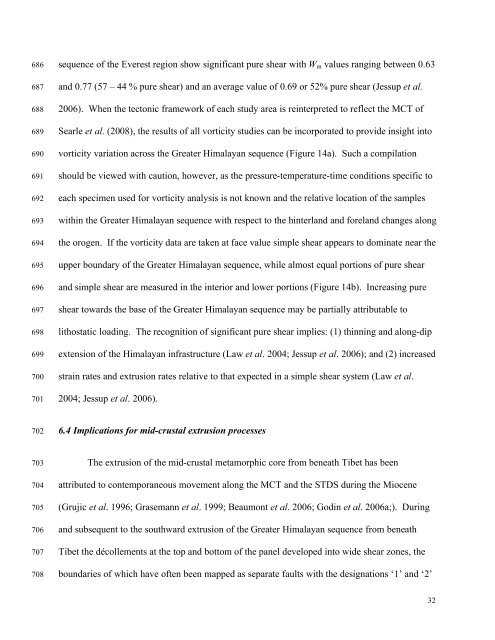Kinematics of the Greater Himalayan sequence, Dhaulagiri Himal ...
Kinematics of the Greater Himalayan sequence, Dhaulagiri Himal ...
Kinematics of the Greater Himalayan sequence, Dhaulagiri Himal ...
You also want an ePaper? Increase the reach of your titles
YUMPU automatically turns print PDFs into web optimized ePapers that Google loves.
686<br />
687<br />
688<br />
689<br />
690<br />
691<br />
692<br />
693<br />
694<br />
695<br />
696<br />
697<br />
698<br />
699<br />
700<br />
701<br />
<strong>sequence</strong> <strong>of</strong> <strong>the</strong> Everest region show significant pure shear with W m values ranging between 0.63<br />
and 0.77 (57 – 44 % pure shear) and an average value <strong>of</strong> 0.69 or 52% pure shear (Jessup et al.<br />
2006). When <strong>the</strong> tectonic framework <strong>of</strong> each study area is reinterpreted to reflect <strong>the</strong> MCT <strong>of</strong><br />
Searle et al. (2008), <strong>the</strong> results <strong>of</strong> all vorticity studies can be incorporated to provide insight into<br />
vorticity variation across <strong>the</strong> <strong>Greater</strong> <strong><strong>Himal</strong>ayan</strong> <strong>sequence</strong> (Figure 14a). Such a compilation<br />
should be viewed with caution, however, as <strong>the</strong> pressure-temperature-time conditions specific to<br />
each specimen used for vorticity analysis is not known and <strong>the</strong> relative location <strong>of</strong> <strong>the</strong> samples<br />
within <strong>the</strong> <strong>Greater</strong> <strong><strong>Himal</strong>ayan</strong> <strong>sequence</strong> with respect to <strong>the</strong> hinterland and foreland changes along<br />
<strong>the</strong> orogen. If <strong>the</strong> vorticity data are taken at face value simple shear appears to dominate near <strong>the</strong><br />
upper boundary <strong>of</strong> <strong>the</strong> <strong>Greater</strong> <strong><strong>Himal</strong>ayan</strong> <strong>sequence</strong>, while almost equal portions <strong>of</strong> pure shear<br />
and simple shear are measured in <strong>the</strong> interior and lower portions (Figure 14b). Increasing pure<br />
shear towards <strong>the</strong> base <strong>of</strong> <strong>the</strong> <strong>Greater</strong> <strong><strong>Himal</strong>ayan</strong> <strong>sequence</strong> may be partially attributable to<br />
lithostatic loading. The recognition <strong>of</strong> significant pure shear implies: (1) thinning and along-dip<br />
extension <strong>of</strong> <strong>the</strong> <strong><strong>Himal</strong>ayan</strong> infrastructure (Law et al. 2004; Jessup et al. 2006); and (2) increased<br />
strain rates and extrusion rates relative to that expected in a simple shear system (Law et al.<br />
2004; Jessup et al. 2006).<br />
702<br />
6.4 Implications for mid-crustal extrusion processes<br />
703<br />
704<br />
705<br />
706<br />
707<br />
708<br />
The extrusion <strong>of</strong> <strong>the</strong> mid-crustal metamorphic core from beneath Tibet has been<br />
attributed to contemporaneous movement along <strong>the</strong> MCT and <strong>the</strong> STDS during <strong>the</strong> Miocene<br />
(Grujic et al. 1996; Grasemann et al. 1999; Beaumont et al. 2006; Godin et al. 2006a;). During<br />
and subsequent to <strong>the</strong> southward extrusion <strong>of</strong> <strong>the</strong> <strong>Greater</strong> <strong><strong>Himal</strong>ayan</strong> <strong>sequence</strong> from beneath<br />
Tibet <strong>the</strong> décollements at <strong>the</strong> top and bottom <strong>of</strong> <strong>the</strong> panel developed into wide shear zones, <strong>the</strong><br />
boundaries <strong>of</strong> which have <strong>of</strong>ten been mapped as separate faults with <strong>the</strong> designations ‘1’ and ‘2’<br />
32

















